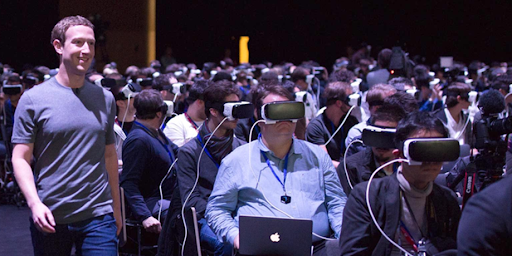
It’s impossible to fathom extended reality in a century, let alone 10 years. The possibilities are endless. Future generations might become accustomed to daily XR usage; perhaps they’ll be living in a primarily augmented world. There are certainly good things to come out of this: the freedom and creativity derived from an augmented/virtual reality is extensive and truly liberating. However, we may find ourselves in a dark place if we don’t focus on XR’s issues at hand. A dissociation between realities, or the uncertainty of what is real, may become all the more common as XR’s popularity increases with technological advancements. As promising as extended reality might be, its potential to dissociate one from reality creates an immense issue that will only prevail with time.
The possibilities of extended reality are just coming into form now, and as I’ve mentioned above, it seems further implications of XR are inevitable. Certainly, future technologies will only enhance recreation possibilities, contributing to sports, cinematic experiences, and most obviously gaming. Companies may implement XR into the workplace, allowing for real-feel virtual meetings and innovative projects. And travelers may be able to encounter all the wonderful sights, smells, and sounds of our planet right from their living room. These possibilities excite a large population that may use XR on a regular basis. However, we must question the nature of such technology as it becomes a foundational aspect of life. Many might spend far more time in extended realities than time experiencing life as is. This itself isn’t necessarily problematic, but the blurred lines between realities are.
I for one have experienced some dissociation associated with virtual reality. With all the excitement present in experiencing a virtual world lies a transition back into this reality. For instance, when I take off an Oculus headset, I seem to be in a dazed state; a bit dizzy and uncertain of where I am as I ‘reenter’ reality. And I always lose a sense of time, which is unusual for me; I could have been using that Oculus for ten minutes or two hours…. it doesn’t seem to make that much of a difference in a virtual world. Despite this transition back to reality, I continually go back to VR when the chance presents itself; the experiences are always fun. Perhaps I am just a ‘noob’, as I’ve only used VR a handful of times.
Nevertheless, I’ve pondered if my experience aligns with other XR users. After some friends described a similar transition from VR back to the room they were in, I decided to do some research. According to Beata Sokolowska, the dissociation between reality isn’t uncommon. Studies conducted on XR users reveal that many have suffered delusions due to the cognitive overlap of worlds. Furthermore, some users have reported that they are unable to decipher what is real after using XR. For example, a user that experiences an augmented reality might be uncertain about sounds or sights, confused on which reality those stimulations belong to. Potential ways to mitigate these issues are being explored, but technology is rapidly expanding, making it hard for researchers to keep up. And technology will only enhance the features of virtual/augmented worlds, allowing for realistic experiences with state-of-the-art sensory mechanics. This seems to swell the severity and frequency of these delusions.
Thus, the question of how this will impact our younger/future generations must be asked. Virtual reality headsets seem to be increasingly popular amongst children; perhaps increasing a developing mind’s exposure to XR will only contribute to a blurred perception of reality, or a false perception of reality altogether. The idea of perceived realities was first hypothesized by Plato, an influential philosopher of ancient Greece, in his Allegory of the Cave. In this allegory, a group of prisoners are chained-up to face the wall of a cave, unable to move. Their reality consists of faint echoes and shadows reflected onto the wall. In Reality+, author David Chalmers connects Plato’s cave to the real word. Specifically, he compares the cave to the image above that shows Mark Zuckerberg walking by an audience of VR users. Chalmers claims that the image is “a contemporary illustration of Plato’s cave”. The two certainly share a striking resemblance; the audience even looks confused as they enter a virtual world that stimulates their senses. Seemingly unaware of Zuckerberg’s presence, they adjust to their temporary reality as Plato’s cave dwellers adjust to theirs.
Of course, this one picture cannot accurately depict our world, but it can give us insight on a world we might be entering as XR’s horizons expand. Considering XR’s current dissociative limitations, younger generations increased exposure to such technologies, and a contemporary depiction of Plato’s cave all together is alarming. These characteristics display a certain dissociative dystopia, a futuristic depiction of Plato’s cave, and one that very well might come true. Perhaps the great philosopher was right thousands of years ago. Increased exposure, especially from a young age, will undoubtedly contribute to further dissociation between realities. There will be a disconnect we’ve never experienced if we ignore XR’s dissociative issues at hand.
XR technologies bring vast excitement that can certainly make for a better future. However, we must be cautious; there is danger in abusing all things. Dissociation paired with increased usage may cause individual problems, but such issues leave larger doors open. Oppressive governments can take advantage of a weakened citizenry and extend their control. Corporations may take advantage of this dissociation too. We must work to mitigate these potentials, and it starts with combating XR’s blurred lines between reality.
Works Cited
Chalmers, David J. Reality+. First ed., W. W. Norton & Company, 2022, pp. 3–20.
Sokołowska, Beata. “Impact of Virtual Reality Cognitive and Motor Exercises on Brain Health.” International journal of environmental research and public health vol. 20,5 4150. https://www.ncbi.nlm.nih.gov/pmc/articles/PMC10002333/.


